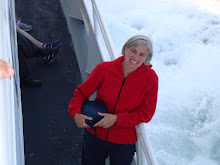KN: The humorous voice is strong and consistent throughout the text. How did you accomplish this feat?
SA: It wasn’t always easy to remain light and irreverent, because a lot of the information in the book covers episodes of human history that weren’t very funny—like plagues and poverty and overcrowding. I didn’t want to come across as uncaring or flippant. But usually I was able to find something light-hearted to focus on. My ultimate goal was to help kids appreciate the amazing ability humans have to cope with bad situations. I also thought it was important for kids to appreciate that the field of public health has only been a priority for civic leaders for the past hundred years or so.
KN: I love the TMI(too much information) sections in the book. Did you plan those out or did the book designer come up with that idea?
SA: It kind of evolved, actually. In an early draft I had a few boxes that I had called “Probably more than you wanted to know” and my editor changed it to TMI. Then we culled out more from the body text and made a few extra TMI boxes.
KN: In order to write this book, you had to do a tremendous amount of research. How much time did you spend researching and how did you organize all of the information?
SA: I did read a lot of books, in whole or in part, as I researched. The research part took about two years, although I wasn’t working exclusively on POOP that whole time. The biggest challenge was organizing it all and then deciding what information was most relevant and/or fun for kids. A good friend of mine who is a writer read an early draft that was perhaps twice as long as the finished manuscript. She gently pointed out to me that not everyone is as excited about sanitation as I am, and that I really had to cut out some of the information. Which I did. And then my editor asked me to make further cuts. Cutting the text forced me to consider what was truly essential to me to keep, and that made it a stronger book.
KN: Reading this book made me really grateful that I live in modern times in a country which has a good sanitation system. You mention that many of the sanitation problems of medieval Europe still exist in developing countries today. Did you visit any of these countries to have a better idea of what it must have been like to live in London or Paris over a hundred years ago?
SA: I lived in Cairo, Egypt for a year, and there I witnessed a great deal of poverty and poor sanitation, both in the urban center and also in the countryside. During the course of my research I also read an amazing book called The People of the Abyss, by Jack London (the writer of White Fang and Call of the Wild). In 1903, London left his comfortable lodgings in the west part of London and traveled to the East End, purchased second-hand clothing, and went to live in a London slum, to experience firsthand what the life was like. He walked the streets, starving and homeless, and then wrote about it. Because he’s such an amazing writer, his account really helped me understand what it must have been like to be poor at that time, when there were virtually no social safety nets. Unfortunately similar situations exist today in many developing countries.
KN: Is there anything else you’d like to share with us?
SA: I hope this book will get kids excited about history. I’m working on a follow-up book about the history of clothes, especially some of the funkier fashions like corsets and codpieces and ruffs and bound feet and bathing costumes and arsenic wafers. I hope the next book will be another fun way for kids to learn a little history—the kind that isn’t in their social studies textbooks.
KN: Thanks for the interview.
SA: A pleasure!
Subscribe to:
Post Comments (Atom)

No comments:
Post a Comment